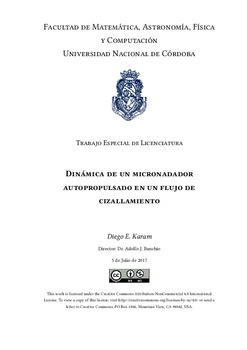| dc.contributor.advisor | Banchio, Adolfo Javier | |
| dc.contributor.author | Karam, Diego Edgardo | |
| dc.date.accessioned | 2017-12-27T16:03:15Z | |
| dc.date.available | 2017-12-27T16:03:15Z | |
| dc.date.issued | 2017-07-05 | |
| dc.identifier.uri | http://hdl.handle.net/11086/5762 | |
| dc.description | Tesis (Lic. en Física)--Universidad Nacional de Córdoba, Facultad de Matemática, Astronomía, Física y Computación, 2017. | es |
| dc.description.abstract | Utilizando simulaciones numéricas del tipo Dinámica de Stokes, se estudia el movimiento de micronadadores sometidos a un flujo de cizalla.
Resulta de gran interés entender la interacción entre la manera en que se propulsa el micronadador y el flujo ambiente. En particular, si de esta resulta alguna orientación de nado favorecida.
En este trabajo se partió desde una puesta a punto del código de Dinámica de Stokes, adaptándolo para el estudio de micronadadores de interés.
Se encontró que los nadadores cuyos cuerpos tienen simetría de revolución se comportan de manera similar, describiendo órbitas similares a la de los esferoides autopropulsados.
Finalmente, se estudia un nadador con cuerpo en forma de esferoide y con un flagelo helicoidal rígido y rotante.
En este caso se observa una tendencia del nadador a orientarse en la dirección de la vorticidad del flujo.
Esto puede entenderse a partír del análisis de la dinámica orientacional del cuerpo del nadador sin autoporpulsión sometido a la acción del flujo de cizalla. | es |
| dc.description.abstract | The movement of microswimmers under a shear flow is studied using numerical simulations of the Stokesian Dynamics type. It is of great interest to understand the interaction between a swimmer's self-propulsion and the ambient flow. In particular, if this results in some favored swimming orientation. The start point in this work is a set-up of the Stokes Dynamics code, adapting it for the study of microswimmers of interest . It was found that swimmers whose bodies have a revolution symmetry behave similarly, describing orbits similar to that of self-propelled spheroids. Finally, a swimmer with a body in the shape of a spheroid and with a rigid and rotating helical flagellum is studied. In this case, a tendency of the swimmer to orientate itself in the direction of the vorticity of the flow is observed. This can be understood as part of the analysis of the dynamics orientation of the body of the swimmer without self-propulsion subjected to the action of shear flow. | en |
| dc.language.iso | spa | es |
| dc.rights | Atribución-NoComercial 4.0 Internacional. | |
| dc.rights.uri | https://creativecommons.org/licenses/by-nc/4.0/ | |
| dc.subject | Low Reynolds number motions | es |
| dc.subject | Swimming microorganisms | es |
| dc.subject | Analytical and numerical techniques | es |
| dc.subject | Low Reynolds number (creeping) flows | es |
| dc.subject.other | Flujo laminar | es |
| dc.subject.other | Bajo número de Reynolds | es |
| dc.subject.other | Dinámica de Stokes | es |
| dc.subject.other | Simulaciones numéricas | es |
| dc.title | Dinámica de un micronadador autopropulsado en un flujo de cizallamiento | es |
| dc.type | bachelorThesis | es |





